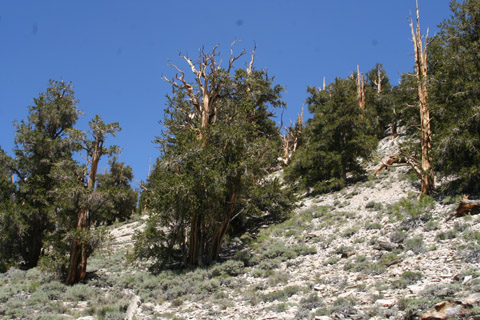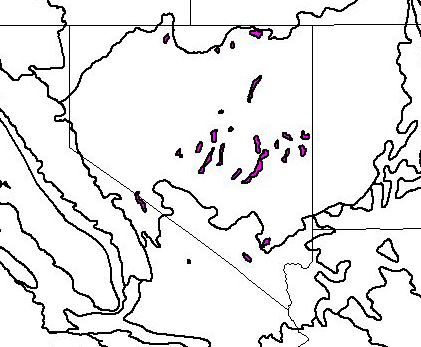
Schulman Grove of Great Basin bristlecone pine (Pinus longaeva), Inyo Co., California
Bioimages home (click on an image to enlarge)
view
this page in its intended navigation context
Great Basin montane forests
(WWF
ecoregion NA0515)

Schulman Grove of Great Basin bristlecone pine (Pinus
longaeva), Inyo Co., California

Source of bioregions data:
Olson, D. M. and
E. Dinerstein. The Global 200: Priority ecoregions for global conservation. (PDF
file) Annals of the Missouri Botanical Garden 89:125-126.
Distinctiveness (1=highest,4=lowest): 3 (bioregionally
outstanding)
This naturally fragmented area supports some species that occur only on one or a
few peaks. The elevation gradients result in high local diverslty.*
Conservation Status (1=most endangered, 5=most
intact): 3 (vulnerable)
25 to 50% of this region remains intact. Fire suppression and grazing have
changed species composition and allowed exotic plant species to invade.*
 | Pinus edulis | (pinyon pine) |
 | Juniperus spp., e.g. | (juniper) |
 | Pseudotsuga menziesii | (Douglas fir) |
Abies concolor (white fir)
Pinus flexilis (limber pine)
Pinus longaeva (Great Basin bristlecone pine)
 Pinus
albicaulis (white bark pine)
Pinus
albicaulis (white bark pine)
 | Tsuga mertensiana | (mountain hemlock) |
 | Pinus contorta | (lodgepole pine) |
 | Populus tremuloides | (quaking aspen) |
Associated habitats


Forest, White
Mountains, Inyo Co., California.
(c) 2005 Daniel P.
Duran
hires
hires
Schulman Grove, Inyo National Forest, White Mountains, California






(left) Great Basin bristlecone pines (Pinus longaeva) have a relatively
normal size and morphology on the relatively moist north-facing slopes. (2nd
from left) However, on the drier south-facing slopes smaller, stunted trees may
actually be centuries older. (center two images) Under drought conditions
trees may die back and maintain a smaller growing surfaces. (2nd from right)
At the lower elevations, trees face near-desert conditions and have severely
restricted growth, (right) Even after dying, dead trunks may remain standing for
hundreds of years. This image shows the high Sierras to the west which
remove most of the moisture from the air that moves over them.
(c) 2011 Steven J.
Baskauf
hires
hires
hires
hires
hires
hires


Cross sections of bristlecone pine (Pinus longaeva) trunks, Left:
When a bristlecone loses part of its crown, it responds by allowing part of the
trunk to die while maintaining a narrow strip of living bark. This "slab
growth" can be seen in this cross section. The narrow, light colored
crescent on the right edge was the only part of the trunk with living bark.
Right: Cross section of about 3000 years of growth rings. The oldest living
Great Basin bristlecone is 4600 years old and still growing in the Schulman
Grove in the White Mountains.
(c) 2005 Steven J.
Baskauf
hires
hires
* Ricketts, T.H., E. Dinerstein, D.M. Olson, C.J. Loucks, et al. (1999) Terrestrial Ecoregions of North America: A Conservation Assessment. World Wildlife Fund - United States and Canada. Island Press, Washington, D.C. pp. 248-250.
Except as noted, images copyright 2002-2005 Steve Baskauf - Terms of use